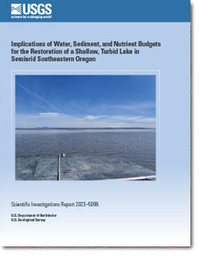Implications of Water, Sediment, and Nutrient Budgets for the Restoration of a Shallow, Turbid Lake in Semiarid Southeastern Oregon
Links
- Document: Report (3.2 MB pdf) , HTML , XML
- Data Releases:
- USGS data release - Stage-volume-area table for Malheur Lake, Oregon, 2021
- USGS data release - Phytoplankton data for Malheur Lake, Oregon, 2018–2020
- Download citation as: RIS | Dublin Core
Abstract
Malheur Lake is the largest lake in the endorheic Harney Basin in southeastern Oregon. Since the 1990s, Malheur Lake—which averages depths of about 1 meter—has been in a degraded, turbid state lacking submergent and emergent vegetation. The goals of this study were to identify the major sources of sediment and nutrients to Malheur Lake to determine the importance of managing nutrients for lake restoration. Discrete water samples were analyzed for nutrient (total phosphorus, total nitrogen, orthophosphate, nitrate+nitrite, and ammonia) and suspended-sediment concentrations, and additional parameters including chlorophyll-a and phytoplankton biomass were measured in lake samples. Lake area fluctuated from a minimum of 3,300 hectares (ha) to a maximum of 11,300 ha in water years 2019 and 2020. In water year 2019, inflow from the tributaries created a 1,400-hectare area in the lake with low turbidity that persisted for multiple months. Land-use practices and water diversions along the tributaries affected the hydrographs and nutrient and suspended-sediment concentrations reaching the lake. As lake area increased, storage of sediment-associated constituents in the water column increased in excess of external loads because of resuspension. In 2019, 69 percent of the increase in suspended-sediment storage in the water column was attributed to internal resuspension and 31 percent was from external loading. Sediment was deposited as lake area decreased, and water-column storage decreased even as positive external loading continued. The internal resuspension, deposition, and external loading of suspended sediment likely is decreasing topographic heterogeneity in the lake. Concentrations of total phosphorus and orthophosphate are substantially higher than in the 1980s, and the lake is eutrophic. Phytoplankton in the lake was light limited in 2019–20, and restoration actions that prioritize vegetation establishment would reduce bioavailable nutrients for phytoplankton while increasing light in the water column.
Suggested Citation
Smith, C.D., and Wood, T.M., 2023, Implications of water, sediment, and nutrient budgets for the restoration of a shallow, turbid lake in semiarid southeastern Oregon: U.S. Geological Survey Scientific Investigations Report 2023–5098, 31 p., https://doi.org/10.3133/sir20235098.
ISSN: 2328-0328 (online)
Study Area
Table of Contents
- Acknowledgments
- Abstract
- Introduction
- Study Site
- Water Budget Methods
- Nutrient and Suspended-Sediment Budget Methods
- Water Budget Results
- Nutrient and Suspended-Sediment Budget Results
- Summary
- References Cited
- Appendixes 1–2
| Publication type | Report |
|---|---|
| Publication Subtype | USGS Numbered Series |
| Title | Implications of water, sediment, and nutrient budgets for the restoration of a shallow, turbid lake in semiarid southeastern Oregon |
| Series title | Scientific Investigations Report |
| Series number | 2023-5098 |
| DOI | 10.3133/sir20235098 |
| Publication Date | September 18, 2023 |
| Year Published | 2023 |
| Language | English |
| Publisher | U.S. Geological Survey |
| Publisher location | Reston, VA |
| Contributing office(s) | Oregon Water Science Center |
| Description | Report: viii, 31 p.; 2 Data Releases |
| Country | United States |
| State | Oregon |
| Other Geospatial | Malheur Lake |
| Online Only (Y/N) | Y |


